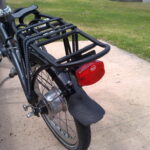In this guide, we’ll learn how to clean a mountain bike and find the secrets to maintaining its pristine condition. A clean mountain bike not only looks impressive but also functions at its peak, offering smoother rides and improved longevity.
Cleaning your mountain bicycle is essential for its health and performance. It also lets you spot issues early, avoiding costly repairs. In essence, it enhances your biking experience, extends your bike’s life, and keeps it a reliable companion on every adventure.
We’ll walk you through a straightforward step-by-step process, covering everything from the frame to the drivetrain and brakes. Learn about the essential cleaning supplies and expert tips suitable for riders of all levels.
So, let’s get started!
What Supplies Do You Need to Clean Your Mountain Bike?
- Cleaning Brushes
- Degreaser
- Lubricants
- Bucket or Basin
- Bike Stand
- Chain Lubrication Applicator
- Water Source
- Protective Gear (Gloves and Safety Glasses)
- Mild Soap or Bike-Specific Cleaner
Pre-Cleaning Inspection
A thorough examination of your mountain bike before cleaning serves as a preventative measure against unexpected breakdowns during rides. It not only keeps you safe on the trail but also saves you from costly repairs or replacements down the road.
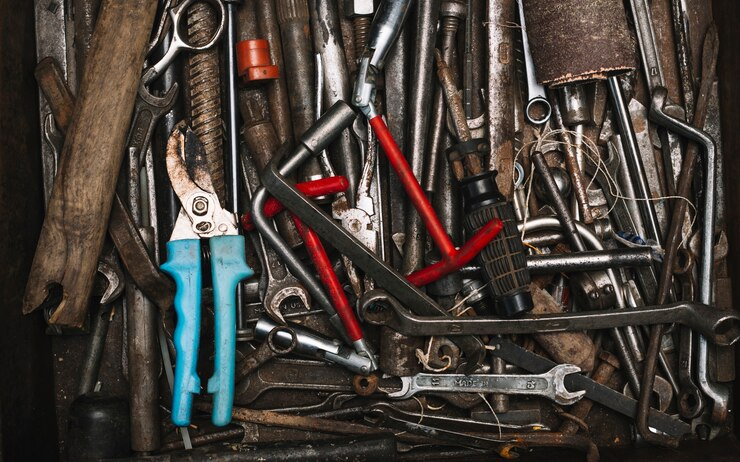
Moreover, a well-maintained bike offers a superior riding experience, with smoother handling and improved performance. So, before you reach for the cleaning supplies, take a moment to inspect your mountain bicycle—it’s a small effort that goes a long way in preserving your bike’s condition and your riding pleasure.
How to Clean a Mountain Bike?
How to Clean Your Mountain Bike Frame?
Cleaning the frame and fork of your mountain bicycle is a fundamental step in its maintenance routine. Start by rinsing off the bike with a hose or a bucket of water to remove loose dirt and debris. Then, prepare a cleaning solution using a mild soap or a bicycle-specific cleaner mixed with water.

Using a soft-bristle brush or a sponge, gently scrub the frame and fork, paying close attention to areas with accumulated dirt or mud.
For stubborn grime, consider using a bike-specific degreaser. Apply it to the affected areas and allow it to sit for a few minutes before you begin scrubbing them.
Afterward, rinse the frame and fork thoroughly with clean water, ensuring that all cleaning residues are removed. Pat dry with a clean cloth or allow the bicycle to air dry.
This meticulous cleaning process not only keeps your bike looking pristine but also protects against corrosion, ensuring the long-term integrity of the frame and fork.
How to Clean Your Mountain Bike Chain?
The drivetrain is the heart of your mountain bicycle, and maintaining it is essential for a smooth and efficient ride. Begin by shifting the bike to the smallest chainring and rear cog to access the drivetrain components easily.
Apply a bicycle-specific degreaser to the chain, cassette, and derailleurs, allowing it to sit for a few minutes to break down dirt and grime.
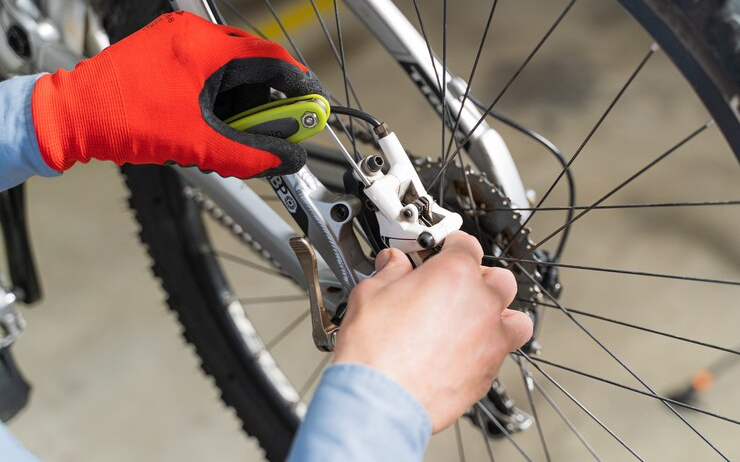
Using a stiff-bristle brush, scrub the chain and cassette while pedaling backward. This action effectively removes dirt from the chain’s rollers and cogs.
Rinse off the degreaser and dirt thoroughly with clean water. Then, use a clean cloth to wipe down the chain and derailleurs, ensuring they are dry before proceeding.
Finally, apply a high-quality chain lubricant evenly to the chain, wiping off any excess to prevent dirt buildup. Properly maintaining your drivetrain not only extends its lifespan but also ensures seamless gear shifting and pedaling efficiency.
How to Clean Your Mountain Bike Brakes?
Brake maintenance is paramount for rider safety, and cleaning the brake components should not be overlooked. Begin by inspecting the brake pads for wear; if they are significantly worn, replace them to maintain optimal braking performance.
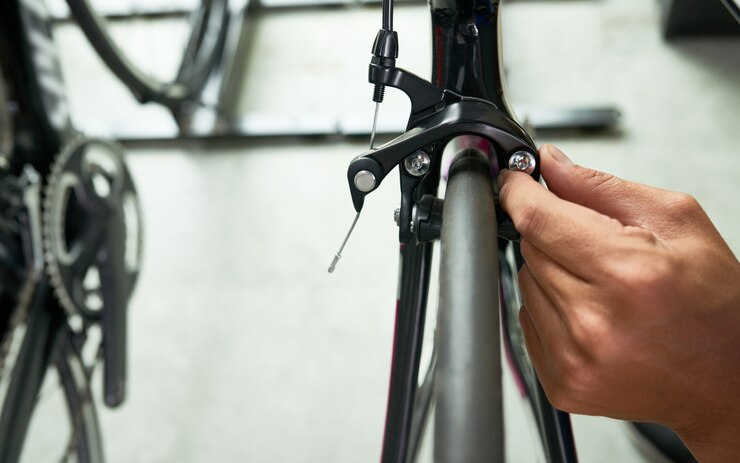
Use a mild soap or a bicycle-specific cleaner to clean the brake calipers, rotors, and brake pads, being careful not to contaminate the brake pads with cleaning products. Inspect the brake rotors for warping or damage, and if necessary, clean them with isopropyl alcohol to remove any contaminants.
After the cleaning process, it’s essential to test your brakes to ensure they are functioning correctly. If any issues with brake performance are noted, consult a professional for maintenance or adjustments.
A well-maintained brake system provides reliable stopping power, enhancing your safety on the trail.
How to Clean Your Mountain Bike Wheels?
The wheels and tires of your mountain bike encounter various elements and terrains, which is why they must be cleaned regularly. Start by rinsing off loose dirt and mud from the wheels and tires.
Then, use a wheel brush to clean the rims and spokes carefully. A sponge or cloth can be used to wipe down the tires, removing dirt and debris.
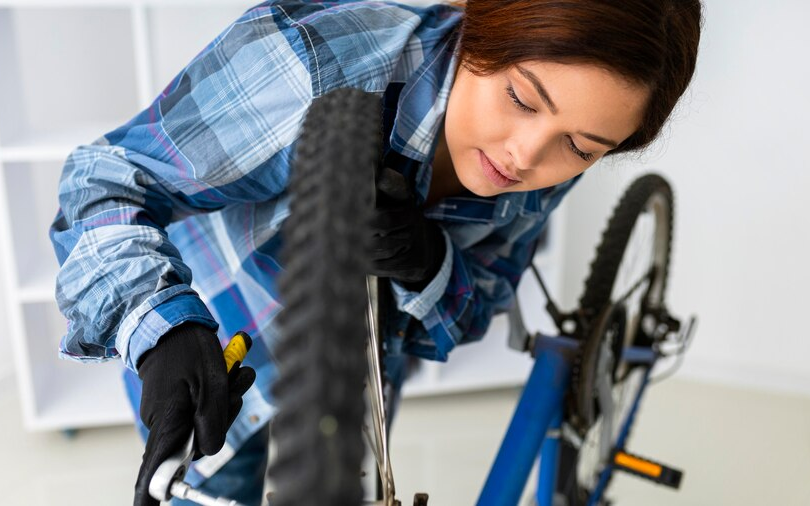
While cleaning the tires, take the opportunity to inspect them for cuts, punctures, or excessive wear. Ensure that the tires are properly inflated according to the manufacturer’s recommendations, as proper tire maintenance guarantees a comfortable and safe riding experience.
How to Clean Your Mountain Bike Suspension?
Maintaining your suspension components is vital for a smooth and controlled ride on challenging terrain. Use a mild soap or a bike-specific cleaner to clean the stanchions and sliders of your suspension fork and rear shock.
Be cautious not to use harsh chemicals that may damage seals and bushings. Consider using specialized suspension products for more in-depth maintenance tasks, such as changing suspension oil or servicing air chambers.

It’s crucial to have suspension components periodically inspected and serviced by a qualified technician to ensure they function optimally and provide the desired performance on the trail.
Proper suspension maintenance contributes significantly to your overall biking experience, providing enhanced comfort and control over rough terrain.
Lubrication
Proper mountain bike lubrication is the foundation of bicycle maintenance, and its significance becomes paramount after a thorough cleaning. Post-cleaning, when your bike’s components are exposed and vulnerable, the application of lubricant takes center stage. It serves as a protective shield against friction and wear, ensuring a smoother and more reliable ride.
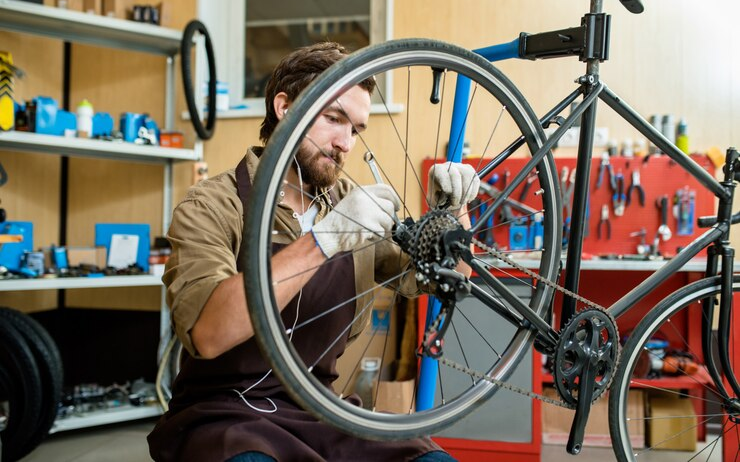
Lubrication can be most effective when applied to the following key areas: the chain, where even distribution of bike-specific lubricant while pedaling backward is crucial; derailleurs, which benefit from lubrication at pivot points; cables, for smoother cable action; pedals, cleats, and other moving parts.
Lubrication not only extends the life of your bicycle but also guarantees optimal performance on the demanding terrain that mountain biking enthusiasts conquer.
Final Inspection and Safety Check
Performing a thorough final inspection and safety check of your bike is a crucial pre-ride ritual that guarantees a safe and hassle-free cycling experience. Start by examining the tires for damage and ensuring proper tire pressure, enhancing traction and control.

Next, assess the brakes, check for smooth engagement and sufficient stopping power, and inspect the brake pads for wear. Confirm precise shifting through all gears and maintain a well-lubricated chain. Inspect suspension components (if applicable), wheels, and hubs for smooth operation and adjust as needed.
Don’t overlook bolt and fastener tightness, frame integrity, handlebar controls, and the functionality of lights and reflectors if riding at night. Prioritize your safety by wearing protective gear like a helmet and gloves.
This comprehensive final inspection and safety check ensures your bike is in optimal working condition and ready for your next adventure on the road or trail.
Post-Cleaning Tips and Storage
After a thorough bicycle cleaning session, it’s essential to follow post-cleaning tips for proper storage and maintenance. When storing your clean bike, consider hanging it in a cool, dry place to prevent moisture accumulation.
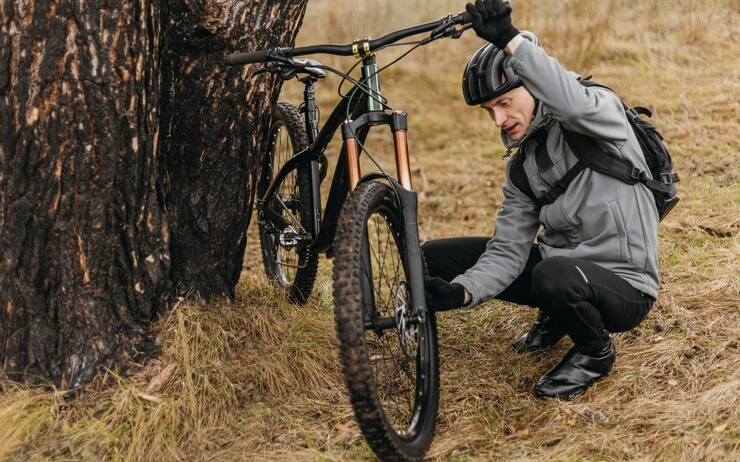
To safeguard against rust, apply a light coat of bike-specific lubricant to metal components, including the chain, cassette, and bolts. Additionally, elevate the bicycle off the ground to avoid tire deformation and reduce contact with wet surfaces.
Regularly check tire pressure and lubrication, and perform quick safety checks to ensure your bike remains in top condition between rides. By following these recommendations, you’ll not only extend the life of your bicycle but also ensure that it’s always ready for your next adventure trip.
Conclusion
We hope you finally got to know how to clean a mountain bike. Now, it’s time to let your passion for adventure be matched by the reliability of a meticulously maintained mountain bicycle. Beyond aesthetics, regular cleaning ensures longevity and optimal functionality.
By understanding the intricacies of cleaning each component – from frame to suspension – and incorporating proper lubrication, your bike becomes a reliable companion on any trail. Follow our post-cleaning tips to safeguard against rust and maintain top-notch conditions.
Your mountain bicycle is not just a mode of adventure but a well-maintained partner ready for your next thrilling ride.
FAQs
Clean your bicycle after muddy rides or every 1-2 weeks.
Avoid daily water washing; it can damage bearings. Wipe the dirt regularly.
Never use petrol; it can damage paint and components.
To make your bicycle shine, use bike-specific polish or wax.



